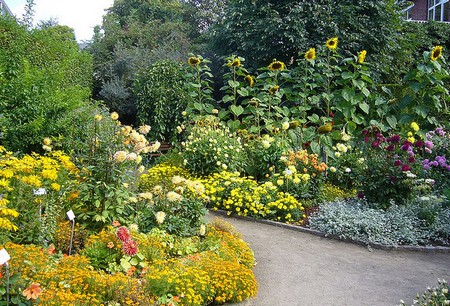Color is the most powerful natural force in any garden. It offers infinite variety, immensely evocative qualities and the ability to catch and hold the eye like no other element in the garden. In horticulture, color has the finest natural medium of expression there is-plant.
Without plants, a garden is nothing; without colorful plants, it is incomplete. Plants offer every color of the rainbow, every nuance of the spectrum, uniquely combining each infinitesimal hue and tone with countless different textures, shapes and sizes. From the brilliant blues, yellows and reds of spring annuals to the delicate, ghostly striations of winter barks, plants offer every color and shade known to the human eye.
Given their limitless versatility, it is no wonder that colorful plants offer the greatest range of natural short cuts to beautiful gardens. Many of these plants are fully hardy throughout the year, others more delicate and ephemeral, but they all offer spellbinding powers of evocation. Plant a colorful garden, and very soon you will have a beautiful garden.
Color Contrasts and harmonies
Color preference is an emotional choice which plants can normally fulfil admirably. However, scientifically, color is classified according to its hue, value and intensity. For this reason, for gardeners it is a color wheel that offers the greatest practical assistance when choosing a particular color and deciding whether it harmonizes or contrasts with another.
In the late seventeenth century Sir Isaac Newton invented a wheel formed of seven colors – red, orange, yellow, green, blue, indigo, and violet. In the 1800s the American A.H. Munsell made a color wheel of five main colors, with a further five intermediate colors between them. Nowadays, a simpler wheel formed of three basic colors – red, yellow and blue – with secondary colors where they overlap is the one that is principally used. Such a wheel indicates complementary color and ones that harmonize with each other. Complementary colors are those with no common pigments, while harmonizing colors share the same pigments.
Dramatic or demure?
Whichever color combinations you require in your garden, there are usually plants that can provide them.
A color wheel can be used to show how plant colors may be selected to create dramatic features, or more subtle color displays in your garden.
A color wheel formed of three basic colors, with others created where they overlap, shows complementary and harmonizing colors. For example, yellow and violet, blue and orange, and red and green are complementary colors, whereas yellow harmonizes with green and orange, blue with green and violet, and red with orange and violet.
Shiny and matt surfaces
The surface texture of plants’ leaves, stems and flowers dramatically influences the amount of light reflected from the plants in the garden and thus the perceived vibrancy of a border. A smooth surface reflects light at the same angle at which the rays hit it. This makes the light purer in color than similar light reflected from a matt surface. So, for really bright, clear colors, select plants that have smooth, shiny surfaces.
Categories
Advertisements
Recent Articles
 How to Understand Bed Sizes – A Small Guide
How to Understand Bed Sizes – A Small Guide How to Select Some Must Have Kitchen Accessories
How to Select Some Must Have Kitchen Accessories Best Way to Change a Car Tire
Best Way to Change a Car Tire Best Way to Write an Affirmation
Best Way to Write an Affirmation Best Way to Take Charge of Your Financial Life
Best Way to Take Charge of Your Financial Life Best Way to Survive a Party When You Don’t Know Anyone
Best Way to Survive a Party When You Don’t Know Anyone Best Way to Stop Self Sabotaging Yourself
Best Way to Stop Self Sabotaging Yourself Best Way to Start Journal Writing
Best Way to Start Journal Writing Best Way to Speak with a Powerful Voice
Best Way to Speak with a Powerful Voice Best Way to Simplify Your Life
Best Way to Simplify Your Life Best Way to Respond to a Put-Down
Best Way to Respond to a Put-Down Best Way to Reduce Acne Breakouts
Best Way to Reduce Acne Breakouts Best Way to Recover from Dining Disasters
Best Way to Recover from Dining Disasters Best Way to Quit Your Job Gracefully
Best Way to Quit Your Job Gracefully Best Way to Make Your Own Website
Best Way to Make Your Own Website



Leave a Reply